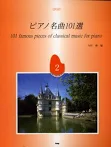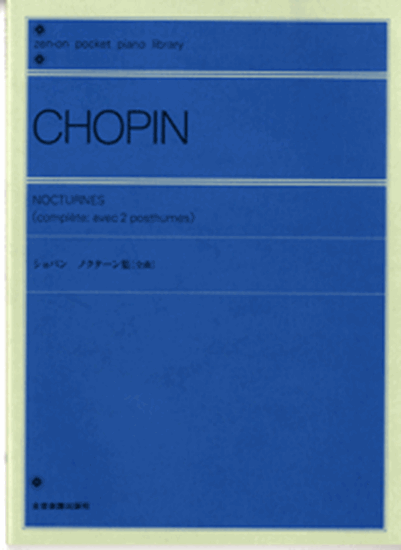Chopin, Frederic : Nocturne No.2 Es-Dur Op.9-2
Work Overview
Genre:nocturne
Total Playing Time:3 min 30 sec
Copyright:Public Domain
Commentary (2)
Author : Hayashikawa, Takashi
Last Updated: January 15, 2019
[Open]
Author : Hayashikawa, Takashi
Nocturne Op.9 No.2
Undoubtedly the most well-known of Chopin's nocturnes, numerous arrangements for violin, cello, and voice were actively created after his death.
With the exception of the final two measures, all phrases in the piece consist of four measures and can be diagrammed as follows:
Throughout the piece, the left hand consistently maintains the same accompaniment pattern, over which the right-hand melody sings. The B section in B-flat major appears in almost the same form both times, but the A and C sections are adorned with different embellishments each time they appear. This method of melodic ornamentation originated from the performance practice of opera arias of the time, and Chopin, who loved vocal music, actively incorporated it into his piano playing. It is said that Chopin himself played these embellishments differently each time, and numerous variations differing from the published score remain, some transcribed from Chopin's own performances, others written by Chopin into his pupils' scores (such a wealth of surviving material is rare for Chopin's works. Some even include the right hand descending in chromatic thirds from the highest register). Chopin's circle, including Delacroix, recognized his genius in this improvisational ability and his capacity to freely alter the timbre with each performance. This performance practice of his significantly differs from an aesthetic that prioritizes "score-faithful" performance.
In contrast to the straightforward A section, the B section features contrasting, somewhat wandering harmonies: in the first measure, it seems to move to the first inversion of V in B-flat major, only for the bass to descend a semitone in the next measure, progressing to IV–I in E-flat major (Musical Example 1, m. 10). Then, the bass ascends a semitone, returning to B-flat major, and just when stability seems to be achieved, a sudden chromatic harmony appears just before returning to A (Musical Example 2). The "wandering harmony" that characterizes Chopin's works in general was likely also derived, to some extent, from his improvisational sensibility.
Musical Example 1: Measures 9–10
Musical Example 2: Measures 11–12
(Takashi Hayashikawa)
Author : Ooi, Kazurou
Last Updated: March 12, 2018
[Open]
Author : Ooi, Kazurou
No. 2, Op. 9-2, E-flat Major
This is an extremely famous Nocturne, yet it is actually a "frightening" one, as merely listening to its performance reveals the depth of the pianist. Technically, it is not particularly difficult, but musically, it is a challenging piece. Chopin, as a composer, might at first glance seem to emphasize homophony, but he was in fact a master of polyphony. The left-hand accompaniment in this Nocturne is not merely a succession of chords; rather, the horizontal lines of the two-note and three-note chords flow with intricate precision. A detailed analysis here would be lengthy, but please be aware of its meticulous construction.
Analyzing only the melody line of the first measure, one can observe a simple descent from G, tracing the diatonic notes of this key: G, F, E-flat. If the first measure is G, F, E-flat, then the second measure is C, B, A-flat (I am currently picking out only the important notes). When considered broadly in this way, it is natural that the E-flat in the first measure should be weaker than F, and F should be weaker than G. While there might be debate regarding G and F, for E-flat, which is a complete chord resolution, no emphasis should be placed on this note. Similarly, no emphasis should be placed on the A-flat in the second measure.
Now, measures 3-4 can be treated as a single unit, or as two separate entities. If we consider them as a two-measure unit, it becomes clear that the piece is divided into three phrases: measure 1, measure 2, and measures 3-4. Since each phrase has a different mood, they should be differentiated by varying dynamics and tone quality. Measure 4 is the cadential section, so the tempo should be slightly slowed down. When leaping from the melody's B on the first beat to the D more than an octave above, take ample time. Then, on the second beat, Chopin writes a low B in the bass. Here too, never rush; take your time leisurely.
Technically, there are two important points to note within these four measures:
- One is the issue of balance: reduce the volume so that the left hand never becomes too loud. Rather than reducing the bass, reduce the inner voices.
- The other is the discussion of rubato. When the author heard the worst performance of this piece, it brought to mind radio calisthenics. Not only this Nocturne, but all of Chopin's pieces require rubato. In other words, the key to rubato is timing that goes against expectations. Be careful that the eighth notes in the left hand do not maintain the same timing under any circumstances. Always vary the timing.
Furthermore, what the performer must fundamentally perceive is the character of the chords. This changes the mood. For example, the chord on the second beat of measure 1 is B-natural-D-F-A-flat. The bass E-flat is a pedal point, so it is not counted. This chord on the second beat could perhaps also be B-flat-D-F-A-flat or E-flat-G-B-flat and still be musical. However, Chopin's use of B-natural-D-F-A-flat here creates a unique mood. On the fourth beat, the bass should ideally be E-flat. However, Chopin writes the passing tone D to lead to the C in the next measure. This D, coinciding with the melody's E-flat, creates a distinctive mood. Incidentally, try playing this D as E-flat. It will still be a piece, but you will find it remarkably bland.
In measure 2, following the dominant chord C-E-G-B-flat, a borrowed vii chord appears, resolving to ii on the fourth beat. This section is somewhat strong in expression mood-wise, but ultimately leads to the "joy" of measures 3-4.
From this point onward, it becomes necessary to consider the character of the chords and what mood Chopin intended to evoke.
Arrangements & Related Works(5)
yamaha music foundation & yamaha music media corporation: 大人のためのピアノ悠々塾 初級編 改訂版 Nocturne No.2 Op.9-2 Es-Dur
Key: Es-Dur Total Performance Time: 1 min 30 sec
Ozone, Makoto: NOCTURN NO.2 OP.9-2
Total Performance Time: 5 min 00 sec
PTNA & Partner Channel Videos(25items) View More
Reference Videos & Audition Selections(4items)
Sheet MusicView More
Scores List (116)

(株)ヤマハミュージックエンタテインメントホールディングス

(株)全音楽譜出版社

(株)全音楽譜出版社

(株)全音楽譜出版社

(株)全音楽譜出版社

(株)ドレミ楽譜出版社

(株)全音楽譜出版社

(株)全音楽譜出版社

(株)全音楽譜出版社

(株)ドレミ楽譜出版社

(株)音楽之友社

KMP(ケイ・エム・ピー) ケイエムピー

(株)全音楽譜出版社

ミュージックランド

ミュージックランド

ミュージックランド

(株)リットーミュージック

KMP(ケイ・エム・ピー) ケイエムピー

ミュージックランド

ミュージックランド

(株)ドレミ楽譜出版社

(株)自由現代社

(株)リットーミュージック

ミュージックランド

(株)ドレミ楽譜出版社

(株)学研プラス

ミュージックランド

(株)全音楽譜出版社

KMP(ケイ・エム・ピー) ケイエムピー

(株)ヤマハミュージックエンタテインメントホールディングス

ミュージックランド

(株)ドレミ楽譜出版社

(株)ドレミ楽譜出版社

(株)ヤマハミュージックエンタテインメントホールディングス

ミュージックランド

ミュージックランド

ミュージックランド

(株)シンコーミュージックエンタテイメント

(株)リットーミュージック

ミュージックランド

(株)全音楽譜出版社

(株)ヤマハミュージックエンタテインメントホールディングス

(株)リットーミュージック

(株)ヤマハミュージックエンタテインメントホールディングス

(株)シンコーミュージックエンタテイメント

(株)全音楽譜出版社

ハンナ(ショパン)

(株)ヤマハミュージックエンタテインメントホールディングス

(株)ヤマハミュージックエンタテインメントホールディングス

(株)ヤマハミュージックエンタテインメントホールディングス

(株)ヤマハミュージックエンタテインメントホールディングス

(株)ドレミ楽譜出版社

(株)ヤマハミュージックエンタテインメントホールディングス

カワイ出版

ハンナ(ショパン)

ハンナ(ショパン)

ミュージックランド

ミュージックランド

ミュージックランド

(株)シンコーミュージックエンタテイメント

(株)ドレミ楽譜出版社

(株)シンコーミュージックエンタテイメント

KMP(ケイ・エム・ピー) ケイエムピー

(株)ヤマハミュージックメディア

(株)シンコーミュージックエンタテイメント

(株)シンコーミュージックエンタテイメント

(株)シンコーミュージックエンタテイメント

ハンナ(ショパン)

(株)リットーミュージック

(株)ドレミ楽譜出版社

(株)共同音楽出版社

ハンナ(ショパン)

(株)ヤマハミュージックエンタテインメントホールディングス

(株)ヤマハミュージックエンタテインメントホールディングス

KMP(ケイ・エム・ピー) ケイエムピー

(株)シンコーミュージックエンタテイメント

ハンナ(ショパン)

(株)ヤマハミュージックエンタテインメントホールディングス

(株)ヤマハミュージックエンタテインメントホールディングス

(株)ヤマハミュージックエンタテインメントホールディングス

ハンナ(ショパン)

(株)ヤマハミュージックエンタテインメントホールディングス

ハンナ(ショパン)

(株)ドレミ楽譜出版社

(株)シンコーミュージックエンタテイメント

(株)ヤマハミュージックエンタテインメントホールディングス

ミュージックランド

(株)ヤマハミュージックエンタテインメントホールディングス

(株)ドレミ楽譜出版社

ミュージックランド

(株)ヤマハミュージックエンタテインメントホールディングス

ミュージックランド

(株)全音楽譜出版社

ミュージックランド

(株)全音楽譜出版社

(株)シンコーミュージックエンタテイメント

ミュージックランド

(株)シンコーミュージックエンタテイメント

KMP(ケイ・エム・ピー) ケイエムピー

(株)シンコーミュージックエンタテイメント

(株)音楽之友社

(株)全音楽譜出版社

(株)音楽之友社

(株)全音楽譜出版社

(株)全音楽譜出版社

(株)全音楽譜出版社

ポーランド音楽出版社

(株)ヤマハミュージックエンタテインメントホールディングス

(株)音楽之友社

(株)ヤマハミュージックエンタテインメントホールディングス

(株)学研プラス

ミュッセ








 第2番 - 演奏動画のサムネイル](http://i.ytimg.com/vi/Cu0q-gXMbPg/mqdefault.jpg)






 第2番 - 演奏動画のサムネイル](http://i.ytimg.com/vi/TZEbSbOBkqA/mqdefault.jpg)
 第2番 Op.9-2 - 演奏動画のサムネイル](http://i.ytimg.com/vi/3XZIEi-U_Po/mqdefault.jpg)







